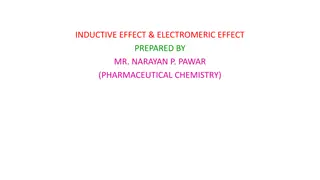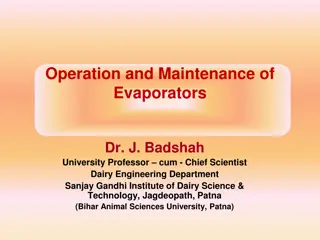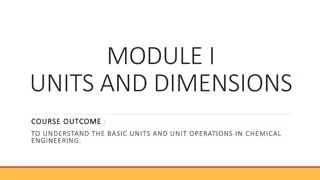Principles and Applications of Multiple Effect Evaporators in Chemical Engineering
This article discusses the operation and design principles of multiple effect evaporators in the context of chemical engineering. It covers the heat transfer mechanisms, efficiency considerations, and calculations involved in these systems, highlighting the benefits of utilizing multiple effects for evaporation processes in industries. The content also explores the significance of steam consumption, specific heat, and temperature differentials in optimizing the performance of evaporator units.
Download Presentation

Please find below an Image/Link to download the presentation.
The content on the website is provided AS IS for your information and personal use only. It may not be sold, licensed, or shared on other websites without obtaining consent from the author. Download presentation by click this link. If you encounter any issues during the download, it is possible that the publisher has removed the file from their server.
E N D
Presentation Transcript
Unit operation (I) Unit operation (I) Department of Chemical and Petroleum Industries Engineering Fourth Year AL-Mustaqbal University Collage Lecture (7) Evaporation (2) 1
2) Multiple effect evaporators a) Forward feed multiple effect evaporators L3 2
General principles Effect 1 Q1= U1A1 T1, where T1= (T0 T1), To= inlet steam temp., T1= temp of effect 1 Effect 2 Q2= U2A2 T2, where T2= (T1 T2), T1= temp of D1, T2= temp of effect 2 Effect 3 Q3= U3A3 T3, where T3= (T2 T3). T2= temp of D2, T3= temp of effect 3 Neglecting the heat required to heat the feed from Tfto T1, the heat Q1transferred across A1appears as latent heat in the vapor D1and is used as steam in the second effect, and: Q1= Q2= Q3 So that: U1A1 T1= U2A2 T2= U3A3 T3 If the individual effects are identical, A1= A2= A3, and: U1 T1= U2 T2= U3 T3 This, however, represents a simplification, since: 3
(a) The heat required to heat the feed from Tfto T1has been neglected, and (b) The liquor passing from (1) to (2) carries heat into the second effect, and this is responsible for some evaporation; similarly for the third effect The latent heat required to evaporate 1 kg of water in (1), is approximately equal to the heat obtained in condensing 1 kg of steam at T0. Thus 1 kg of steam fed to (1) evaporates 1 kg of water in (1). Again the 1 kg of steam from (1) evaporates about 1 kg of water in (2). Thus, in a system of N effects,1 kg of steam fed to the first effect will evaporate in all about N kg of liquid. Q = Q1+ Q2+ Q3= U1A1 T1+ U1A2 T2+ U3A3 T3 The total capacity is: If an average value of the coefficients Uavis taken, then: Q = Uav( T1+ T2+ T3)A (assume the area of each effect is the same) 4
If a single effect is used instead of multiple effect with a temperature difference T and having an area A equal to that of one of the multiple effect with average coefficient Uavwould have the same capacity Q = UavA T . Ex: 4 kg/s (14.4 tons/hour) of a liquor containing 10 per cent solids is fed at 294 K to the first effect of a triple-effect unit. Liquor with 50 per cent solids is to be withdrawn from the third effect, which is at a pressure of 13 kN/m2 (0.13 bar). The liquor may be assumed to have a specific heat of 4.18 kJ/kg K and to have no boiling point rise. Saturated dry steam at 205 kN/m2is fed to the heating element of the first effect, and the condensate is removed at the steam temperature in each effect as shown in Figure above. If the three units are to have equal areas, estimate the area, the temperature differences and the steam consumption. Heat transfer coefficients of 3.1, 2.0 and 1.1 kW/m2K for the first, second, and third effects respectively, may be assumed. 5
L3 Solution: Q1= Q2= Q3 U1A1 T1= U2A2 T2= U3A3 T3 .(1) But the areas are equal i.e. U1 T1= U2 T2= U3 T3 .(2) From steam table at 205 kN/m2the temp. To= 394 K and at 13 kN/m2the temp. T3= 325 K So the total temp. difference T = T1+ T2+ T3= 394 325 = 69 K 6
From Eq. 2 T1= 13 K &T3= 36 K Since the feed is cold, it will be necessary to have a greater value of T1than given by this analysis. It will be assumed that T1= 18 K, T2= 17 K, T3= 34 K. If the latent heats are given by o, 1, 2and 3, then from the Steam Tables in the Appendix: For steam to 1: To= 394 K and o= 2200 kJ/kg For steam to 2: T1= 376 K and 1= 2249 kJ/kg For steam to 3: T2= 359 K and 2= 2293 kJ/kg T3= 325 K and 3= 2377 kJ/kg 7
Assuming that the condensate leaves at the steam temperature, then heat balances across each effect may be made as follows: Effect 1: Do o= GFCp(T1 Tf) + D1 1, OR 2200 Do= 4 4.18(376 294) + 2249 D1 Effect 2: D1 1= (GF D1)Cp(T2 T1) + D2 2, or 2249 D1 = (4 D1)4.18(359 - 376) + 2293 D2 Effect 3: D2 2= (GF D1 D2)Cp(T3 T2) + D3 3, OR 2293 D2= (4 D1 D2)4.18(325 359) + 2377 D3 Where GFis the mass flow rate of liquor fed to the system, and Cpis the specific heat capacity of the liquid, which is assumed to be constant. 8
A material balance over the evaporator is: GF= (D1+ D2+ D3) + L3 Solid material balance 0.1 GF= 0.5 L3 L3= 0.8 kg/s & (D1+ D2+ D3) = 3.2 kg/s Then from the above eqns D1= 0.991kg/s , D2= 1.065 , D3= 1.144kg/s & Do= 1.635 kg/s The area of the surface of each effect necessary to transmit the necessary heat under the given temperature difference may then be obtained as: 9
b) Backward feed multiple effect evaporators: the calculations are similar to the forward feed multiple effect evaporators. c) Parallel feed multiple effect evaporators: also the calculations are similar to (a) & (b). 10
Ex.2: Calculate the boiling temperature and boiling point elevation (BPE) of orange juice concentrate at the pressure of 20 kPa. Assimilate the concentrate to a 45% (w/w) solution of glucose (MW = 180) and assume ideal solution behavior. Solution: The molar concentration (mol. fraction) of the solution is: 0.45/180 = 0.076 xH2O = 1-0.076 = 0.924 0.45/180+ 0.55/18 The vapor pressure of water: yH2OPT= xH2OP*H2O In the vapor there is only water y = 1 1 20 = 0.924 P* P* = 21.6 kPa From steam table: at P = 21.6 kPa T = 61.74oC And at P = 20 kPa T = 60.06oC So the BPE = 61.74 60.06 = 1.68oC 11























